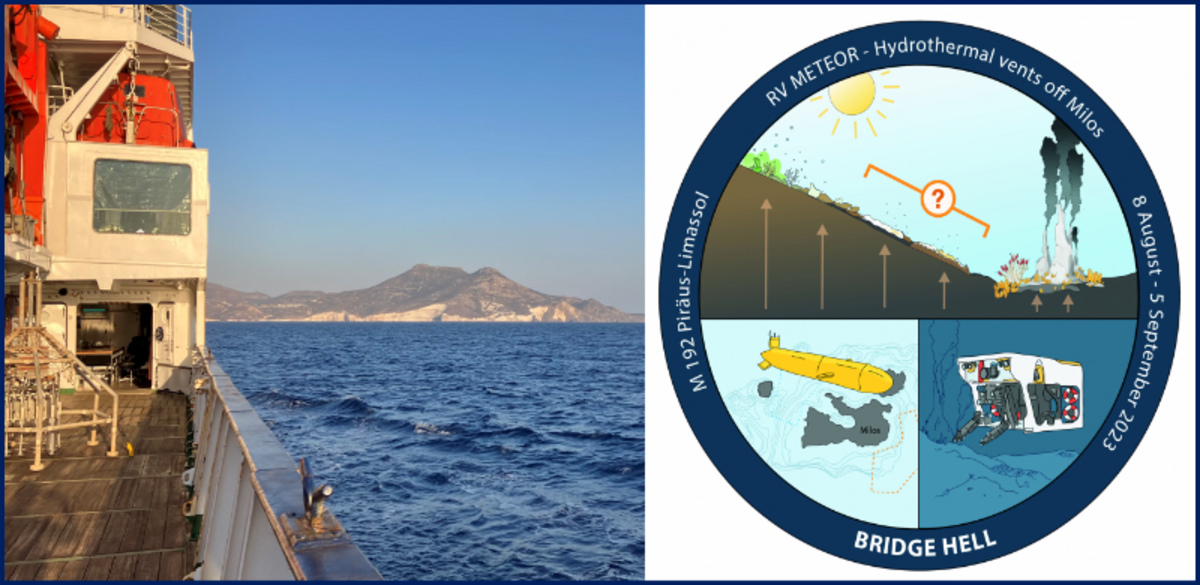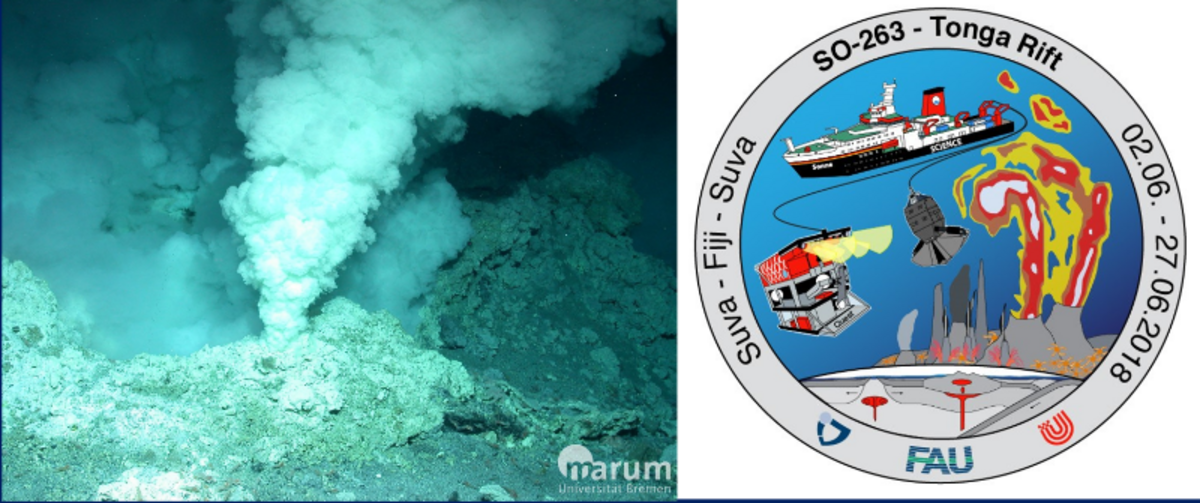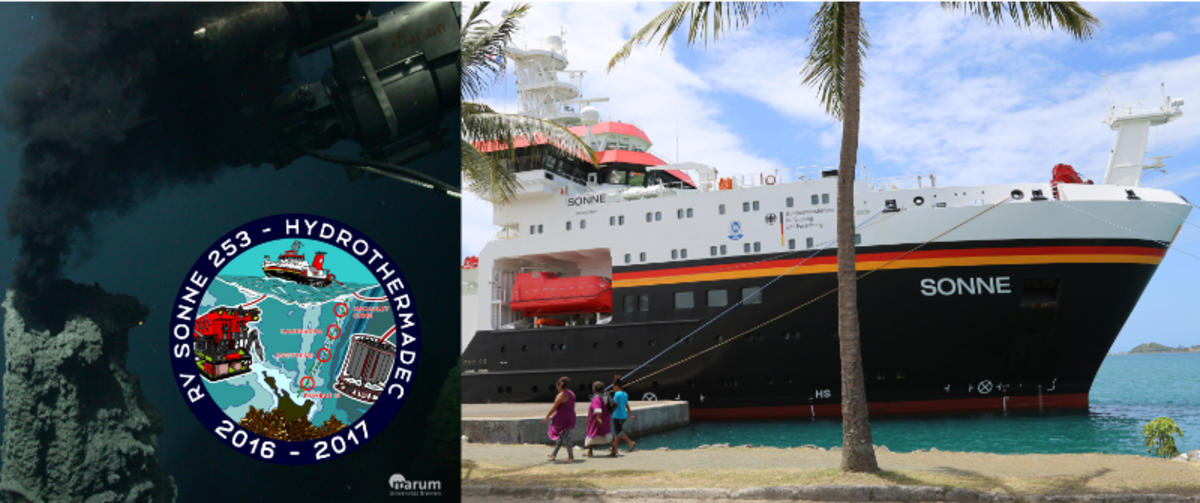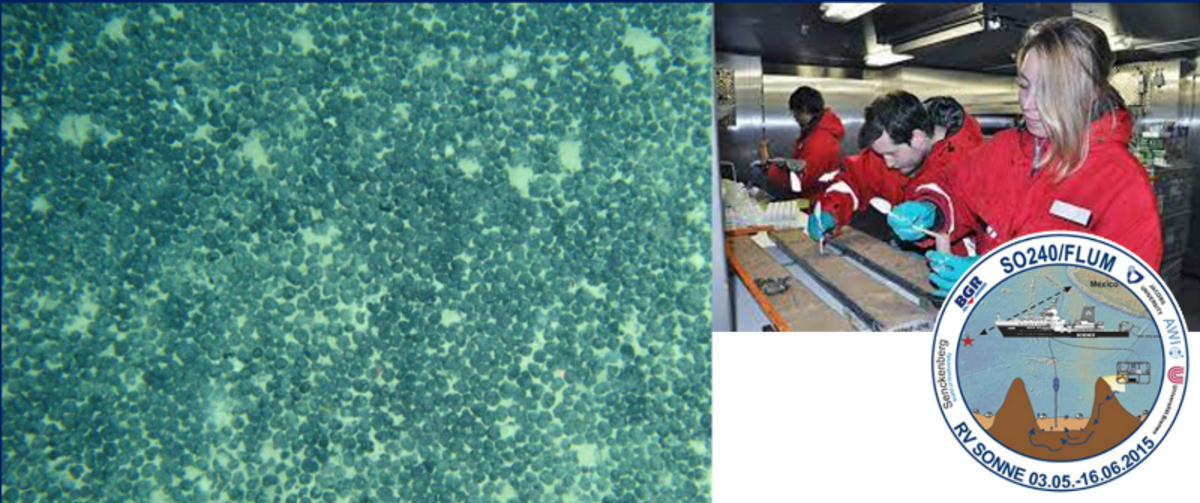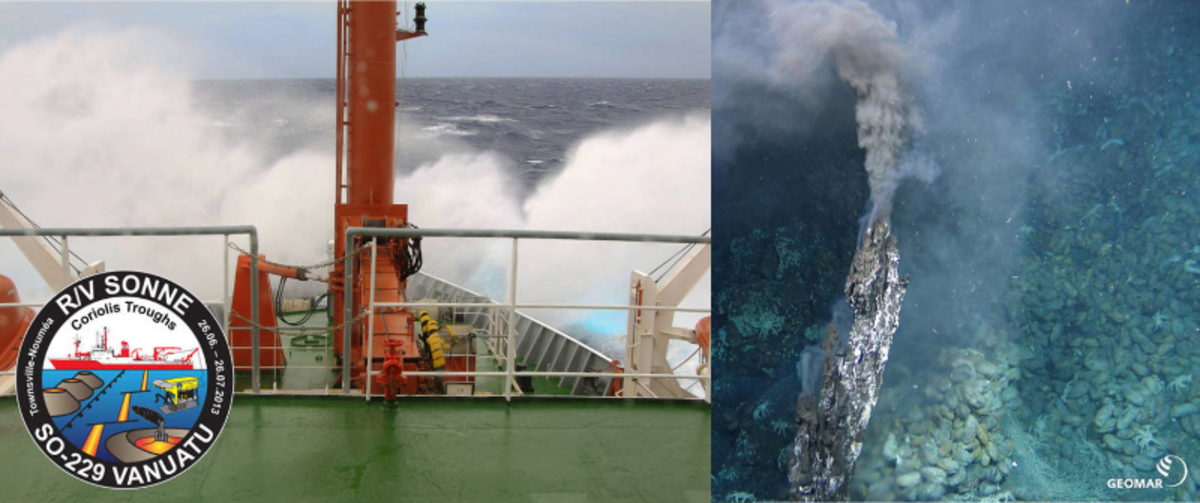Piräus (Griechenland) - Limassol (Zypern) / 20.08.2023 - 05.09.2023
Charlotte Kleint

Dr. Charlotte Kleint
GEO Raum 5320
Klagenfurter Straße 2-4
28359 Bremen, Deutschland
Tel. +49 421 218 65405
E-Mail
z.Zt. in Elternzeit
- Geochemische Fluid-Zusammensetzung von flachen und tiefen Hydrothermalsystemen
- Stabilisierung und Transport von hydrothermalen Metallen in der Wassersäule
- Elementkreisläufe im Ozean
- Organische und anorganische Komplexierung von Spurenmetallen
- Analytik für die Spurenmetall-Bestimmung im Meerwasser
- Marine mineralische Ressourcen
- Wissenschaftskoordination
Hydrothermale Quellen an mittelozeanischen Rücken oder Inselbögen tragen große Mengen verschiedener Spurenmetalle in den Ozean ein. Auf Grund der geringeren Wassertiefe von Inselbögen können ihre hydrothermalen Plumes die photische Zone erreichen - dem Gebiet mit der höchsten Primärproduktivität - und dort direkt wichtige Mikronährstoffe oder potenzielle Toxine wie Eisen, Kupfer, Zink und Arsen zuführen. Laufende Forschungsarbeiten haben gezeigt, dass beispielsweise gelöstes hydrothermales Eisen Tausende von Kilometern von seiner ursprünglichen Quelle entfernt in die Ozeane transportiert wird und so zum globalen ozeanischen Metallhaushalt beiträgt.
Dies ist sowohl auf die anorganische (z.B. in Form von Sulfid-Nanopartikeln) als auch auf die organische Komplexierung durch kleine chelatbildende Moleküle (so genannte organische Liganden) zurückzuführen, was sehr wichtig ist, da dieser Mechanismus die Ausfällung von Metallen verhindert und ihren Transport in den offenen Ozean ermöglicht. Eine ähnliche Bedeutung der organischen Komplexierung wurde für Kupfer nachgewiesen und kann für andere hydrothermale Spurenelemente abgeleitet werden.
Die Auswirkung von flacheren submarinen Vulkanbögen auf die Biogeochemie des Ozeans in der photischen Zone, aber auch darunter, ist jedoch bisher noch nicht gut untersucht worden. Mit meiner Forschung möchte ich zeigen, dass vor allem die Rolle dieser hydrothermalen Quellen im biogeochemischen Kreislauf der Metalle im Ozean sowie die Bioverfügbarkeit der Metalle bisher möglicherweise unterschätzt wurde.
Lebenslauf
Wissenschaftlicher Werdegang
| 2024-2025 | Elternzeit (1 Jahr) |
| seit 2021 | Wissenschaftliche Mitarbeiterin (Senior Scientist, tenured) am MARUM, Universität Bremen |
| 2021-2022 | Elternzeit (1 Jahr) |
| 2016-2021 | Wissenschaftliche Mitarbeiterin, MARUM, Universität Bremen und Jacobs University Bremen |
| 2014 | Forschungsaufenthalt, University of Otago, Neuseeland (3 Monate) |
| 2013-2016 | Promotionsstudentin, Jacobs University Bremen |
| 2012 | Werksstudentin, Jacobs University Bremen |
| 2009-2011 | MSc. in Marine Geosciences, Universität Bremen |
| 2006-2009 | BSc. in Geowissenschaften, Leibniz Universität Hannover |
Expeditionen
Veröffentlichungen
- Dekov VM, Koschinsky A, Yamanaka T, Petersen S, Paul SA, Kleint C, Pelleter E, de Lange GJ, Kürzinger V, Garbe-Schönberg D, Ilieva M, Fouquet Y, Rouxel O (2024): Native sulfur at the seafloor: Composition and origin. Chemical Geology 668, 122295.
| doi:10.1016/j.chemgeo.2024.122295 | - Bohrmann G, Streuff K, Römer M, Knutsen S-M, Smrzka D, Kleint J, Röhler A, Pape T, Sandstå NR, Kleint C, Hansen C, dos Santos Ferreira C, Walter M, de Paula Santos GM, Bach W (2024): Discovery of the first hydrothermal field along the 500-km-long Knipovich Ridge offshore Svalbard (the Jøtul field). Scientific Reports 14, 10168.
| doi:10.1038/s41598-024-60802-3 | - Janssen D, Gilliard D, Rickli J, Nasemann P, Koschinsky A, Hassler CS, Bowie AR, Ellwood MJ, Kleint C, Jaccard SL (2023): Chromium stable isotope distributions in the southwest Pacific Ocean and constraints on hydrothermal input from the Kermadec Arc. Geochimica et Cosmochimica Acta 342, 31-44.
| doi:10.1016/j.gca.2022.12.010 | - Hansen CT, Kleint C, Böhnke S, Klose L, Adam‐Beyer N, Sass K, Zitoun R, Sander SG, Indenbirken D, Dittmar T, Koschinsky A, Perner M (2022): Impact of high Fe‐concentrations on microbial community structure and dissolved organics in hydrothermal plumes: an experimental study. Scientific Reports 12:20723.
| doi:10.1038/s41598-022-25320-0 | - Klose L, Kleint C, Bach W, Diehl A, Wilckens F, Peters C, Strauss H, Haase K, Koschinsky A (2022): Hydrothermal activity and associated subsurface processes at Niuatahi rear-arc volcano, North East Lau Basin, SW Pacific: Implications from trace elements and stable isotope systematics in vent fluids. Geochimica et Cosmochimica Acta 332, 103-123.
| doi:10.1016/j.gca.2022.06.023 | - Kleint C, Zitoun R, Neuholz R, Walter M, Schnetger B, Klose L, Chiswell SM, Middag R, Laan P, Sander SG, Koschinsky A (2022): Trace metal dynamics in shallow hydrothermal plumes at the Kermadec arc. Frontiers in Marine Science 8, 782734.
| doi:10.3389/fmars.2021.782734 | - Dede B, Hansen CT, Neuholz R, Schnetger B, Kleint C, Walke S, Bach W, Amann R, Meyerdierks A (2022): Niche differentiation of sulfur-oxidizing bacteria (SUP05) in submarine hydrothermal plumes. The ISME Journal.
- | doi:10.1038/s41396-022-01195-x |
- Klose L, Keith M, Hafermaas D, Kleint C, Bach W, Diehl A, Wilckens F, Peters C, Strauss H, Klemd R, van Geldern R, Haase KM, Koschinsky A (2021): Trace element and isotope systematics in vent fluids and sulphides from Maka Volcano, north eastern Lau Spreading Centre: Insights into three-component fluid mixing. Frontiers in Earth Science 9:776925.
| doi:10.3389/feart.2021.776925 | - Peters C, Strauss H, Haase K, Bach W, de Ronde CEJ, Kleint C, Stucker V (2021): SO2 disproportionation impacting hydrothermal sulfur cycling: Insights from multiple sulfur isotopes for hydrothermal fluids from the Tonga-Kermadec intraoceanic arc and the NE Lau Basin. Chemical Geology 586, 120586.
| doi:10.1016/j.chemgeo.2021.120586 | - Neuholz R, Kleint C, Schnetger B, Koschinsky A, Laan P, Middag R, Sander SG, Thal J, Türke A, Walter M, Zitoun R, Brumsack H-J (2020): Submarine Hydrothermal Discharge and Fluxes of Dissolved Fe and Mn, and He Isotopes at Brothers Volcano Based on Radium Isotopes. Minerals 10(11), 969 - Special Issue: Advances in Integrated Mineralogical, Geochemical, Isotopic and Numerical Modeling Study of Magmatic-Hydrothermal Systems.
| doi: 10.3390/min101109694 | - Neuholz R, Schnetger B, Kleint C, Koschinsky A, Lettmann K, Sander SG, Türke A, Walter M, Zitoun R, Brumsack H-J (2020): Near-field hydrothermal plume dynamics at Brothers Volcano (Kermadec Arc): A short-lived radium isotope study. Chemical Geology 533.
| doi: 10.1016/j.chemgeo.2019.119379 | - Kleint C, Bach W, Diehl A, Fröhberg N, Garbe-Schönberg D, Hartmann JF, de Ronde CEJ, Sander SG, Strauss H, Stucker V, Thal J, Zitoun R, Koschinsky A (2019): Geochemical characterization of highly diverse hydrothermal fluids from volcanic vent systems of the Kermadec intraoceanic arc. Chemical Geology 528.
| doi: 10.1016/j.chemgeo.2019.119289 | - Böhnke S, Sass K, Gonnella G, Diehl A, Kleint C, Bach W, Zitoun R, Koschinsky A, Indenbirken D, Sander SG, Kurtz S, Perner M (2019): Parameters governing the community structure and element turnover in Kermadec volcanic ash and hydrothermal fluids as monitored by inorganic electron donor consumption, autotrophic CO2 fixation and 16S tags of the transcriptome in incubation experiments. Frontiers in Microbiology 10:2296.
| doi: 10.3389/fmicb.2019.02296 | - Kleint C, Pichler T, Koschinsky A (2017): Geochemical characteristics, speciation and size-fractionation of iron (Fe) in two marine shallow-water hydrothermal systems, Dominica, Lesser Antilles. Chemical Geology 454, 44-53.
| doi: 10.1016/j.chemgeo.2017.02.02 | - Kleint C, Hawkes JA, Sander SG, Koschinsky A (2016): Voltammetric Investigation of Hydrothermal Iron Speciation. Frontiers in Marine Science (Marine Biogeochemistry) 3:75.
| doi: 10.3389/fmars.2016.00075 | - Kleint C, Kuzmanovski S, Powell Z, Bühring SI, Sander SG, Koschinsky A (2015): Organic Cu-complexation at the shallow marine hydrothermal vent fields off the coast of Milos (Greece), Dominica (Lesser Antilles) and the Bay of Plenty (New Zealand). Marine Chemistry 173, 244-252.
| doi: 10.1016/j.marchem.2014.10.012 | - Mohwinkel D, Kleint C, Koschinsky A (2014): Phase associations and potential selective extraction methods for selected high-tech metals from ferromanganese nodules and crusts with siderophores. Applied Geochemistry 43, 13-21.
| doi: 10.1016/j.apgeochem.2014.01.010 |
Koschinsky A, Kleint C (2014): Manganknollen – Rohstoff für Zukunftstechnologien. Beitrag in Geowissenschaftliche Mitteilungen (GMIT) 57, 21-25.
- Kleint C, Bach W, Sander SG, Zitoun R, Middag R, Laan P, Koschinsky A (2019): Hydrothermal fluxes of trace metals (such as Zn and Fe) into surface waters along the the Kermadec Intraoceanic Arc. Goldschmidt-Konferenz 2019, Barcelona, Spanien (Vortrag).
- Kleint C, Bach W, Diehl A, Fröhberg N, Garbe-Schönberg D, Hartmann JF, de Ronde C, Sander SG, Strauss H, Stucker V, Zitoun R, Koschinsky A (2018): Heterogeneous Geochemical Composition of Hydrothermal Fluids from the Kermadec Intraoceanic Arc with Potential Implications for Ocean Biogeochemistry. Gordon Research Conference on Ocean Biogeochemistry (GRC) 2018, Hongkong, China (ausgewählter/eingeladener Vortrag und Poster).
- Kleint C, Bach W, Diehl A, Fröhberg N, Garbe-Schönberg D, Hartmann JF, de Ronde C, Sander SG, Strauss H, Stucker V, Zitoun R, Koschinsky A: Heterogeneous Geochemical Composition of Hydrothermal Fluids from the Kermadec Intraoceanic Arc with Potential Implications for Ocean Biogeochemistry. Gordon Research Seminar on Ocean Biogeochemistry (GRS) 2018, Hongkong, China (Vortrag & Poster).
- Kleint C, Fröhberg N, Zitoun R, Sander SG, Strauss H, Koschinsky A (2017): Diversity of hydrothermal fluids from four vent sites at the Kermadec Island Arc and its relevance for elemental fluxes. Goldschmidt-Konferenz 2017, Le Palais des Congrès de Paris, Paris, Frankreich (Vortrag).
- Kleint C, Sander SG, Koschinsky A (2016): Dissolved Fe and Fe binding ligand concentrations at the hydrothermal vent fields in the Coriolis Troughs, New Hebrides Island Arc. Ocean Sciences Meeting (OSM) 2016, Ernest N. Morial Convention Center New Orleans, Louisiana, USA (Poster).
- Sander SG, Powell Z, Koschinsky A, Kuzmanovski S, Kleint C (2014): Stabilization of dissolved trace metals at hydrothermal vent sites: Impact on their marine biogeochemical cycles. European Geosciences Union General Assembly 2014, Wien, Österreich.
- Kleint C, Kraemer D, Koschinsky A (2014): Phase associations and selective extraction of high-technology metals from ferromanganese nodules and crusts with the siderophore Desferrioxamine B. GeoFrankfurt 2014, Goethe-Universität Frankfurt, Frankfurt (Vortrag).
- Kleint C, Koschinsky A (2014): Copper-ligand complexation at shallow water hydrothermal vents off the coast of Milos and Dominica. Ocean Sciences Meeting (OSM) 2014, Convention Center Honolulu, Hawaii, USA (Poster).
- Kleint C, Koschinsky A, Powell Z (2013): Geo-Bio interactions in shallow water hydrothermal vents and their impact on trace metals. ASLO 2013 Aquatic Sciences Meeting, Ernest N. Morial Convention Center New Orleans, Louisiana, USA (Vortrag).
- Kleint C, Koschinsky A (2012): High-tech metals in marine ferromanganese nodules and crusts: concentrations, phase associations and potential methods of selective extraction. GeoHannover 2012, Leibniz Universität Hannover, Hannover (Vortrag).
- Kleint C, Koschinsky A, Mohwinkel D (2012): High-tech metals in marine ferromanganese nodules and crusts: contents and possibilities of selective extraction. European Mineralogical Conference (EMC) 2012, Goethe-Universität Frankfurt, Frankfurt (Vortrag).
- Koschinsky A, Kleint C, Mohwinkel D, Halbach P, Kuhn T (2011): Extraction of valuable trace metals from ferromanganese nodules and crusts with different chemical leaching agents. Underwater Mining Institute (UMI) 2011, Hilo Hawaiian Hotel, Hawaii, USA.
- GIF Young Scientists Meeting (German-Israeli Foundation for Scientific Research and Development) - "Going Down Into the Abyss: Ocean-Floor Processes, Deep Life, and Climate Archives", MARUM, Bremen, Oktober 2019 (eingeladener Vortrag).
- „Initiative: future-orientated deep-sea mining”, Jacobs University und MARUM, Bremen, 2014, 2015 und 2016 (Koordination und Vortrag).
- „Organic Ligands - A Key Control on Trace Metal Biogeochemistry in the Oceans” SCOR Working Group 139, Sibenik, Kroatien, April 2015.
- „Research in Shallow Marine and Fresh Water Systems” Universität Bremen, Februar 2013 (Vortrag).
- „Voltammetry and Geotraces” COST Action Group ES801 „The Ocean Chemistry of Bioactive Trace Elements and Paleoclimate Proxies”, Sibenik, Kroatien, Oktober 2012 (Vortrag).
Doktorarbeit
- Kleint C (2016): The speciation and organic complexation of iron (Fe) and copper (Cu) in different marine hydrothermal vent systems. Doktorarbeit, Jacobs University Bremen
Masterarbeit
- Kleint C (2011): Phase associations of some rare valuable metals (Pt, Zr, Hf, Nb, Ta, Mo, W, Th and REY) in ferromanganese nodules and crusts and potential methods for selective extraction. Masterarbeit, Universität Bremen
Bachelorarbeit
- Kleint C (2009): The Geochemical and Mineralogical Characterization of Manganese Nodules from the German Exploration Claim. Bachelorarbeit, Leibnitz Universität Hannover
Gutachtertätigkeiten
- Deutsche Forschungsgemeinschaft (DFG)
- Scientific Reports
- Economic Geology
- Marine Chemistry
- Geochemistry, Geophysics, Geosystems
- Environmental Chemistry
- Geofluids
Lehre
- Marine Resources in Space and Time (MSc. Marine Geosciences, WiSe 2022/2023)
- Übungen zur Allgemeinen Chemie für Geowissenschaftler (BSc. Geowissenschaften, WiSe 2022/2023)
- Applied Geochemistry, Environmental Geochemistry, Introduction into Earth and Environmental Sciences, Geochemistry of Aqueous Systems (BSc. Earth and Environmental Sciences, Jacobs University Bremen, 2019-2021)





